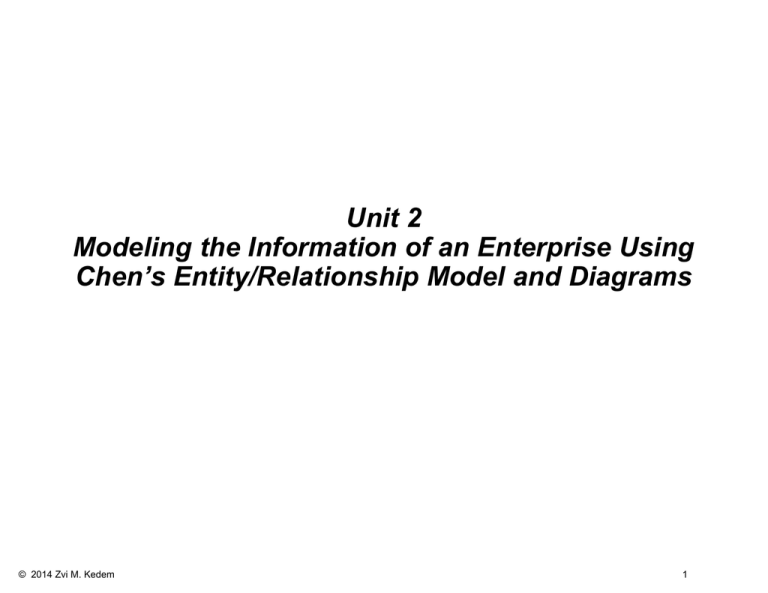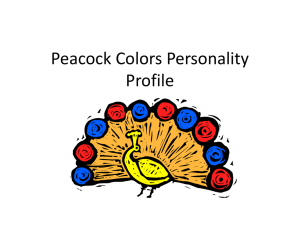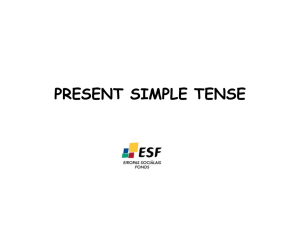
Unit 2
Modeling the Information of an Enterprise Using
Chen’s Entity/Relationship Model and Diagrams
© 2014 Zvi M. Kedem
1
Purpose Of ER Model And Basic Concepts
Entity/relationship (ER) model provides a common,
informal, and convenient method for communication
between application end users (customers) and the
database designers to model the information’s structure
This is a preliminary stage towards defining the database
using a formal model, such as the relational model, to be
described later
The ER model, frequently employs ER diagrams, which
are pictorial descriptions to visualize information’s
structure
ER models are both simple and powerful
© 2014 Zvi M. Kedem
2
Purpose Of ER Model And Basic Concepts
There are three basic concepts appearing in the original
ER model, which has since been extended
We will present the model from more simple to more complex
concepts, with examples on the way
We will go beyond the original ER model, and cover most
of Enhanced ER model
While the ER model’s concepts are standard, there are
several varieties of pictorial representations of ER
diagrams
We will focus on one of them: Chen’s notation
We will also cover Crow’s foot notation in the context of the Visio
tool
Others are simple variations, so if we understand the above, we
can easily understand all of them
You can look at some examples at:
http://en.wikipedia.org/wiki/Entity-relationship_model
© 2014 Zvi M. Kedem
3
Basic Concepts
The three basic concepts are (elaborated on very soon):
Entity. This is an “object.” Cannot be defined even close
to a formal way. Examples:
Bob
Boston
The country whose capital is Paris
There is only one such country so it is completely specified
Relationship. Entities participate in relationships with
each other. Examples:
Alice and Boston are in relationship Likes (Alice likes Boston)
Bob and Atlanta are not in this relationship
Attribute (property). Examples:
Age is an attribute of persons
Size is an attribute of cities
© 2014 Zvi M. Kedem
4
Entity And Entity Set
Entity is a “thing” that is distinguished from others in our
application
Example: Alice
All entities of the same “type” form an entity set; we use
the term “type” informally
Example: Person (actually a set of persons). Alice is an entity in
this entity set
What type is a little tricky sometimes
Example. Do we partition people by sex or not?
Sometimes makes sense (gave birth)
This allows better enforcement of constraints. You could
“automatically” make sure that only entities in the set of women,
but not in the set of men can give birth
Sometimes not (employment)
© 2014 Zvi M. Kedem
5
Entity And Entity Set
Example. When we say “the set of all Boeing airplanes,” is
this
The set of all models appearing in Boeing’s catalog (abstract
objects), or
The set of airplanes that Boeing manufactured (concrete objects)
We may be interested in both and have two entity sets
that are somehow related
We will frequently use the term “entity” while actually
referring to entity sets, unless this causes confusion
© 2014 Zvi M. Kedem
6
Entity And Entity Set
Pictorially, an entity set is denoted by a rectangle with its
type written inside
By convention, singular noun, though we may not adhere
to this convention if not adhering to it makes things clearer
By convention, capitalized, or all capitals, if acronym
Person
© 2014 Zvi M. Kedem
7
Attribute
An entity may have (and in general has) a set of zero or
more attributes, which are some properties
Each attribute is drawn from some domain (such as
integers) possibly augmented by NULL (more about
NULLs later)
All entities in an entity set have the same set of properties,
though not generally with the same values
Attributes of an entity are written in ellipses (for now solid
lines) connected to the entity
Example: FN: “First Name.” LN: “Last Name.” DOB: “Date of
Birth.”
FN
LN
DOB
Person
© 2014 Zvi M. Kedem
8
Attribute
Attributes can be
Base (such as DOB); or derived denoted by dashed ellipses (such as
Age, derived from DOB and the current date)
Simple (such as DOB); or composite having their component attributes
attached to them (such as Address, when we think of it explicitly as
consisting of street and number and restricting ourselves to one city only)
Singlevalued (such as DOB); or multivalued with unspecified in
advance number of values denoted by thick-lined ellipses (such as Child;
a person may have any number of children; we do not consider children
as persons in this example, this means that they are not elements of the
entity set Person, just attributes of elements of this set)
Number
Child
FN
LN
DOB
Street
Address
Age
Person
© 2014 Zvi M. Kedem
9
Attribute
To have a simple example of a person with attributes
Child: Bob
Child: Carol
FN: Alice
LN: Xie
DOB: 1980-01-01
Address.Number: 100
Address.Street: Mercer
Age: Current Date minus DOB specified in years (rounded down)
Number
Child
FN
LN
DOB
Street
Address
Age
Person
© 2014 Zvi M. Kedem
10
Sets, Subsets, and Supersets
Relations subset and superset are defined among sets
It is analogous to
Let us review by an example of three sets
A = {2,5,6}
B = {1,2,5,6,8}
C = {2,5,6}
Then we have
A B and A is a subset of B
and A is a proper subset, actually is not all of B; A B
A C and A is a subset of C
and A is not a proper subset, actually is equal to C; A = C
Caution: sometimes is used to denote what we denote
by
© 2014 Zvi M. Kedem
11
Keys
Most of the times, some subset (proper or not) of the
attributes of an entity has the property that two different
entities in an entity set must differ on the values of these
attributes
This must hold for all conceivable entities in our database
Such a set of attributes is called a superkey (“weak”
superset of a key: either proper superset or equal)
A minimal superkey is called a key (sometimes called a
candidate key).
This means that no proper subset of it is itself a superkey
Longitude
Latitude
Country
State
Name
Size
City
© 2014 Zvi M. Kedem
12
Keys
Informally: superkey values can identify an individual
entity but there may be unnecessary attributes
Informally: key value can identify an individual entity but
there are no unnecessary attributes
Example: Social Security Number + Last Name form a
superkey, which is not a key as Social Security Number is
enough to identify a person
© 2014 Zvi M. Kedem
13
Keys
In our example:
Longitude and Latitude (their values) identify (at most) one City,
but only Longitude or only Latitude do not
(Longitude, Latitude) form a superkey, which is also a key
(Longitude, Latitude, Size, Name) form a superkey, which is not a
key, because Size and Name are superfluous
(Country, State, Name) form another key (and also a superkey, as
every key is a superkey)
For simplicity, we assume that every country is divided
into states and within a state the city name is unique
Longitude
Latitude
Country
State
Name
Size
City
© 2014 Zvi M. Kedem
14
Primary Keys
If an entity set has one or more keys, one of them (no
formal rule which one) is chosen as the primary key
In SQL the other keys, loosely speaking, are referred to
using the keyword UNIQUE
In the ER diagram, the attributes of the primary key are
underlined
So in our example, one of the two below:
Longitude
Latitude
Country
State
Name
Size
State
Name
Size
City
Longitude
Latitude
Country
City
© 2014 Zvi M. Kedem
15
Relationship
Several entity sets (one or more) can participate in a
relationship
Relationships are denoted by diamonds, to which the
participating entities are “attached”
A relationship could be binary, ternary, ….
By convention, a capitalized verb in third person singular
(e.g., Likes), though we may not adhere to this convention
if not adhering to it makes things clearet
© 2014 Zvi M. Kedem
16
Relationship
We will have some examples of relationships
We will use three entity sets, with entities (and their
attributes) in those entity sets listed below
Person
Name
Vendor
Company
Product
Type
Chee
IBM
computer
Lakshmi
Apple
monitor
Marsha
Dell
printer
Michael
HP
Jinyang
© 2014 Zvi M. Kedem
17
Binary Relationship
Let’s look at Likes, listing all pairs of (x,y) where person x
Likes product y, and the associated ER diagram
First listing the relationship informally (we omit article “a”):
Chee likes computer
Chee likes monitor
Lakshmi likes computer
Marsha likes computer
Note
Not every person has to Like a product
Not every product has to have a person who Likes it (informally,
be Liked)
A person can Like many products
A product can have many person each of whom Likes it
Name
Person
© 2014 Zvi M. Kedem
Type
Likes
Product
18
Relationships
Formally we say that R is a relationship among (not
necessarily distinct) entity sets E1, E2, …, En if and only if
R is a subset of E1 × E2 ×…× En (Cartesian product)
In our example above:
n=2
E1 = {Chee, Lakshmi, Marsha, Michael, Jinyang}
E2 = {computer, monitor, printer}
E1 × E2 = { (Chee,computer), (Chee,monitor), (Chee,printer),
(Lakshmi,computer), (Lakshmi,monitor), (Lakshmi,printer),
(Marsha,computer), (Marsha,monitor), (Marsha,printer),
(Michael,computer), (Michael,monitor), (Michael,printer),
(Jinyang,computer), (Jinyang,monitor), (Jinyang,printer) }
R = { (Chee,computer), (Chee,monitor), (Lakshmi,computer),
(Marsha,monitor) }
R is a set (unordered, as every set) of ordered tuples, or
sequences (here of length two, that is pairs)
© 2014 Zvi M. Kedem
19
Relationships
Let us elaborate
E1 × E2 was the “universe”
It listed all possible pairs of a person liking a product
At every instance of time, in general only some of this
pairs corresponded to the “actual state of the universe”; R
was the set of such pairs
© 2014 Zvi M. Kedem
20
Important Digression
Ultimately, we will store (most) relationships as tables
So, our example for Likes could be
Likes
Name
Type
Chee
Computer
Chee
Monitor
Lakshmi Computer
Marsha
Monitor
Where we identify the “participating” entities using their
primary keys
© 2014 Zvi M. Kedem
21
Ternary Relationship
Let’s look at Buys listing all tuples of (x,y,z) where person
x Buys product y from vendor z
Let us just state it informally:
Chee buys computer from IBM
Chee buys computer from Dell
Lakshmi buys computer from Dell
Lakshmi buys monitor from Apple
Chee buys monitor from IBM
Marsha buys computer from IBM
Marsha buys monitor from Dell
Person
Buys
Product
Vendor
© 2014 Zvi M. Kedem
22
Relationship With Nondistinct Entity Sets
Let’s look at Likes, listing all pairs of (x,y) where person x
Likes person y
Let us just state it informally
Chee likes Lakshmi
Chee likes Marsha
Lakshmi likes Marsha
Lakshmi likes Michael
Lakshmi likes Lakshmi
Marsha likes Lakshmi
Note that pairs must be ordered to properly specify the
relationship, Chee likes Lakshmi, but Lakshmi does not
like Chee
Name
Person
© 2014 Zvi M. Kedem
Likes
23
Relationship With Nondistinct Entity Sets
Again:
Chee likes Lakshmi
Chee likes Marsha
Lakshmi likes Marsha
Lakshmi likes Michael
Lakshmi likes Lakshmi
Marsha likes Lakshmi
Formally Likes is a subset of the Cartesian product
Person × Person, which is the set of all ordered pairs of
the form (person,person)
Likes is the set { (Chee,Lakshmi), (Chee,Marsha),
(Lakshmi,Marsha), (Lakshmi,Michael),
(Lakshmi,Lakshmi), (Marsha,Lakshmi) }
Likes is an arbitrary directed graph in which persons serve
as vertices and arcs specify who likes whom
© 2014 Zvi M. Kedem
24
Important Digression
Ultimately, we will store (most) relationships as tables
So, our example for Likes could be
Likes
Name
Name
Chee
Lakshmi
Chee
Marsha
Lakshmi Marsha
Lakshmi Michael
Lakshmi Lakshmi
Marsha
Lakshmi
Where we identify the “participating” entities using their
primary keys
But it is difficult to see (unless we keep track of columns
order) whether Lakshmi Likes Michael or Michael Likes
Lakshmi
© 2014 Zvi M. Kedem
25
Relationship With Nondistinct Entity Sets
Frequently it is useful to give roles to the participating
entities, when, as here, they are drawn from the same
entity set.
So, we may say that if Chee likes Lakshmi, then Chee is
the “Liker” and Lakshmi is the “Liked”
Roles are explicitly listed in the diagram, but the
semantics of they mean cannot be deduced from looking
at the diagram only
Name
Liker
Person
Likes
Liked
© 2014 Zvi M. Kedem
26
Important Digression
Ultimately, we will store (most) relationships as tables
So, our example for Likes could be
Likes
Liker
Liked
Chee
Lakshmi
Chee
Marsha
Lakshmi Marsha
Lakshmi Michael
Lakshmi Lakshmi
Marsha
Lakshmi
Where we identify the “participating” entities using their
primary keys but we rename them using roles
So we do not need to keep track of columns order and we
know that Lakshmi Likes Michael and Michael does not
Like(s) Lakshmi, though we still do not know what “Likes”
really means
© 2014 Zvi M. Kedem
27
Relationship With Nondistinct Entity Sets
Consider Buys, listing all triples of the form (x,y,z) where
vendor x Buys product y from vendor z
A typical tuple might be (Dell,printer,HP), meaning that
Dell buys a printer from HP
Vendor
© 2014 Zvi M. Kedem
Buys
Product
28
ER Diagrams
To show which entities participate in which relationships,
and which attributes participate in which entities, we draw
line segments between:
Entities and relationships they participate in
Attributes and entities they belong to
We also underline the attributes of the primary key for
each entity that has a primary key
Below is a simple ER diagram (with a simpler Person than
we had before):
Longitude
Latitude
Country
State
Name
Size
City
Likes
Person
SSN
© 2014 Zvi M. Kedem
Name
29
Further Refinements To The ER Model
We will present, in steps, further refinements to the model
and associated diagrams
The previous modeling concepts and the ones that follow
are needed for producing a data base design that models
a given application well
We will then put it together in a larger comprehensive
example
© 2014 Zvi M. Kedem
30
Relationship With Attributes
Consider relationship Buys among Person, Vendor, and
Product
We want to specify that a person Buys a product from a
vendor at a specific price
Price is not
A property of a vendor, because different products may be sold by
the same vendor at different prices
A property of a product, because different vendors may sell the
same product at different prices
A property of a person, because different products may be bought
by the same person at different prices
© 2014 Zvi M. Kedem
31
Relationship With Attributes
So Price is really an attribute of the relationship Buys
For each tuple (person, product, vendor) there is a value
of price
Price
Person
Buys
Product
Vendor
© 2014 Zvi M. Kedem
32
Entity Versus Attribute
Entities can model situations that attributes cannot model
naturally
Entities can
Participate in relationships
Have attributes
Attributes cannot do any of these
Let us look at a “fleshed out example” for possible
alternative modeling of Buys
© 2014 Zvi M. Kedem
33
Other Choices For Modeling Buys
Price is just the actual amount, the number in $’s
So there likely is no reason to make it an entity as we
have below
Person#
Person
Price
Amount
Buys
Product
Vendor
Vendor#
Product#
We should probably have (as we had earlier less fleshed
out)
Price
Person#
© 2014 Zvi M. Kedem
Person
Buys
Product
Vendor
Vendor#
Product#
34
Other Choices For Modeling Buys
Or should we just have this?
Buys
Person#
Product#
Vendor#
Price
Not if we want to model something about a person, such
as the date of birth of a person or whom a person likes
These require a person to have an attribute (date of birth)
and enter into a relationship (with other persons)
And we cannot model this situation if person is an attribute
of Buy
Similarly, for product and vendor
© 2014 Zvi M. Kedem
35
Binary Relationships And Their Functionality
Consider a relationship R between two entity sets A, B.
We will look at examples where A is the set of persons
and B is the set of all countries
Person
R
Country
We will be making some simple assumptions about
persons and countries, which we list when relevant
© 2014 Zvi M. Kedem
36
Binary Relationships And Their Functionality
Relationship R is called many to one from A to B if and
only if for each element of A there exists at most one
element of B related to it
Example: R is Born (in)
Each person was born in at most one country (maybe not in a
country but on a ship in the middle of an ocean)
Maybe nobody was born in some country as it has just been
established
Person
Born
Country
The picture on the right describes the universe of four
persons and three countries, with lines indicating which
person was born in which country
We will have similar diagrams for other examples
© 2014 Zvi M. Kedem
37
Binary Relationships And Their Functionality
The relationship R is called one to one between A and B
if and only if for each element of A there exists at most
one element of B related to it and for each element of B
there exists at most one element of A related to it
Example: R is Heads
Each Person is a Head (President, Queen, etc.) of at most one
country
Each country has at most one head (maybe the queen died and it
is not clear who will be the monarch next)
In other words, R is one to one, if and only if
R is many to one from A to B, and
R is many to one from B to A
Person
© 2014 Zvi M. Kedem
Heads
Country
38
Binary Relationships And Their Functionality
The relationship is called many to many between A and
B, if it is not many to one from A to B and it is not many to
one from B to A
Example: R is “likes”
Person
© 2014 Zvi M. Kedem
Likes
Country
39
Binary Relationships And Their Functionality
We have in effect considered the concepts of partial
functions of one variable.
The first two examples were partial functions
The last example was not a function
Pictorially, functionality for binary relationships can be
shown by drawing an arc head in the direction to the “one”
© 2014 Zvi M. Kedem
Person
Born
Country
Person
Heads
Country
Person
Likes
Country
40
Binary Relationships And Their Functionality
How about properties of the relationship?
Date: when a person and a country in a relationship first
entered into the relationship (marked also with black
square)
Date
Person
Born
Country
Date
Person
Heads
Country
Date
Person
© 2014 Zvi M. Kedem
Likes
Country
41
Binary Relationships And Their Functionality
Can make Date in some cases the property of an entity
“Slide” the Date to the Person, but not the Country
“Slide” the Date to either the Person or the Country (but not for
both, as this would be redundant)
Cannot “slide” the Date to either “Liker” or “Liked”
Can “slide” if no two squares end up in the same entity
© 2014 Zvi M. Kedem
42
Binary Relationships And Their Functionality
This can be done if the relationship is many-to-one
Then, the property of the relationship can be attributed to
the “many” side
This can be done if the relationship is one-to-one
Then a property of the relationship can be “attributed” to
any of the two sides
© 2014 Zvi M. Kedem
43
Alternate Designs
Entities “inheriting” attributes of relationships when the
relationships are not many to many
Date
Person
Born
Country
Heads
Country
Date
Person
Date
Person
© 2014 Zvi M. Kedem
Heads
Country
44
Aggregation: Relationships As Entities
It is sometimes natural to consider relationships as if they
were entities.
This will allow us to let relationships participate in other
“higher order” relationships
Here each “contract” needs to be approved by (at most)
one agency
Relationship is “made into” an entity by putting it into a
rectangle; note that the edge between Buys and
Approves touches the Buys rectangle but not the Buys
diamond, to make sure we are not confused
© 2014 Zvi M. Kedem
45
Strong And Weak Entities
We have two entity sets
Man
Woman
Woman has a single attribute, SSN
Let us defer discussion of attributes of Man
A woman has 5 sons, the among them John and Richard,
neither of the two is her eldest son and she writes the
following in her will:
My SSN is 123-45-6789 and I leave $100 to my eldest son and $200
to my son John and $300 to my son Richard …
How do we identify these 3 men?
© 2014 Zvi M. Kedem
46
Strong And Weak Entities
A strong entity (set): Its elements can be identified by the
values of their attributes, that is, it has a (primary) key
made of its attributes
Tacitly, we assumed only such entities so far
A weak entity (set): Its elements cannot be identified by
the values of their attributes: there is no primary key made
from its own attributes
Such entities can be identified by a combination of their
attributes and the relationship they have with another
entity set
© 2014 Zvi M. Kedem
47
Man As A Strong Entity
Most entities are strong: a specific entity can be
distinguished from other entities based on the values of its
attributes
We assume that every person has his/her own SSN
Woman is a strong entity as we can identify a specific
woman based on her attributes. She has a primary key:
her own SSN
Man is a strong entity as we can identify a specific man
based on his attributes. He has a primary key: his own
SSN
SSN
Name
Man
© 2014 Zvi M. Kedem
SSN
Son
Name
Woman
48
Man As A Weak Entity
We assume that women are given SSNs
Men are not given SSNs; they have first names only, but
for each we know who the mother is (that is, we know the
SSN of the man’s mother)
Man is a weak entity as we cannot identify a specific man
based on his own attributes and this is indicated by
thick lines around it
Many women could have a son named Bob, so there are
many men named Bob
However, if a woman never gives a specific name to more
than one of her sons, a man can be identified by his name
and by his mother’s SSN
Name
Man
© 2014 Zvi M. Kedem
SSN
Son
Name
Woman
49
Man As A Weak Entity
We could have the following situation of two mothers: one
with two sons, and one with three sons, when we gave
people also heights in inches (just to have additional
attributes that are not necessary for identification)
SSN: 070-43-1234, height: 65
Name: Bob, height 35
Name: Michael, height 35
SSN: 056-35-4321, height 68
Name: Bob, height 35
Name: Davi, height 45
Name: Vijay, height 74
© 2014 Zvi M. Kedem
50
Man As A Weak Entity
Assuming that a woman does not have more than one son
with a specific name
Name becomes a discriminant
Man can be identified by the combination of:
The Woman to whom he is related under the Son relation. This is
indicated by thick lines around Son (it is weak). Thick line
connecting Man to Son indicates the relationship is total on Man
(every Man participates) and used for identification
His Name. His Name is now a discriminant; this is indicated by
double underline
Name
Man
© 2014 Zvi M. Kedem
SSN
Son
Name
Woman
51
Man As A Weak Entity
We need to specify for a weak entity through which
relationship it is identified; this done by using thick
lines
Otherwise we do not know whether Man is identified
through Son or through Works
Name
Company
Works
© 2014 Zvi M. Kedem
Name
Man
SSN
Son
Name
Woman
52
Man As A Weak Entity
Sometimes a discriminant is not needed
We are only interested in men who happen to be first sons
of women
Every Woman has at most one First Son
So we do not need to have Name for Man (if we do not
want to store it, but if we do store it, it is not a
discriminant)
SSN
Man
First
Son
Name
Woman
Note an arrow to the left: each woman has at most one
first son
© 2014 Zvi M. Kedem
53
Man As A Weak Entity
In general, more than one attribute may be needed as a
discriminant
For example, let us say that man has both first name and
middle name
A mother may give two sons the same first name or the
same middle name
A mother will never give two sons the same first name and
the same middle name
The pair (first name, middle name) together form a
discriminant
© 2014 Zvi M. Kedem
54
From Weaker To Stronger
There can be several levels of “weakness”
Here we can say that a horse named “Speedy” belongs to
Bob, whose mother is a woman with SSN 072-45-9867
Weight
Name
Horse
Name
Has
Man
SSN
Son
Name
Woman
A woman can have several sons, each of whom can have
several horses
© 2014 Zvi M. Kedem
55
The ISA Relationship
For certain purposes, we consider subsets of an entity set
The subset relationship between the set and its subset is
called ISA, meaning “is a”
Elements of the subset, of course, have all the attributes
and relationships as the elements of the set: they are in
the “original” entity set
In addition, they may participate in relationships and have
attributes that make sense for them
But do not make sense for every entity in the “original” entity set
ISA is indicated by a triangle
The elements of the subset are weak entities, as we will
note next
© 2014 Zvi M. Kedem
56
The ISA Relationship
Example: A subset that has an attribute that the original
set does not have
We look at all the persons associated with a university
Some of the persons happen to be professors and some
of the persons happen to be students
ID#
Name
Person
ISA
GPA
© 2014 Zvi M. Kedem
Student
Professor
Salary
57
The ISA Relationship
Professor is a weak entity because it cannot be identified
by its own attributes (here: Salary)
Student is a weak entity because it cannot be identified by
its own attributes (here: GPA)
They do not have discriminants, nothing is needed to
identify them in addition to the primary key of the strong
entity (Person)
The set and the subsets are sometimes referred to as
class and subclasses
© 2014 Zvi M. Kedem
58
The ISA Relationship
A person associated with the university (and therefore in
our database) can be in general
Only a professor
Only a student
Both a professor and a student
Neither a professor nor a student
A specific ISA could be
Disjoint: no entity could be in more than one subclass
Overlapping: an entity could be in more than one subclass
Total: every entity has to be in at least one subclass
Partial: an entity does not have to be in any subclass
This could be specified by replacing “ISA” in the diagram
by an appropriate letter
If nothing stated, then no restriction, so effectively O,P
© 2014 Zvi M. Kedem
59
The ISA Relationship
Some persons are professors
Some persons are students
Some persons are neither professors nor students
No person can be both a professor and a student
ID#
Name
Person
D, P
GPA
© 2014 Zvi M. Kedem
Student
Professor
Salary
60
The ISA Relationship
Example: subsets participating in relationships modeling
the assumed semantics more clearly (every person has
one woman who is the birth mother)
Name
Company
SSN
Works
Salary
Person
ISA
Mother
Woman
© 2014 Zvi M. Kedem
61
The ISA Relationship
ISA is really a superclass/subclass relationship
ISA could be specialization: subsets are made out of the
“more basic” set
ISA could be generalization: a superset is made of “more
basic” sets
Again, the diagram could be annotated to indicate this
© 2014 Zvi M. Kedem
62
A More Complex Example
We have several types of employees
Managers
Programmers
Analysts
Other
An employee can be one of the following
Manager
Programmer and/or Analyst
Other
The 3 sets are disjoint, that is
Manager cannot be Programmer or Analyst, or Other
Other cannot be Manager, Programmer, or Analyst
All Employees have some share properties
It is convenient to group Programmers and Analysts
together as they have some shared properties
© 2014 Zvi M. Kedem
63
A Sketch of an ER Diagram
Employee
D, P
Technical
Manager
O, T
Programmer
© 2014 Zvi M. Kedem
Analyst
64
Cardinality Constraints
We can specify how many times each entity from some
entity set can participate in some relationship, in every
instance of the database
In general we can say that
This number is in the interval [i,j], 0 ≤ i ≤ j, with i and j integers,
denoted by i..j; or
This number is at the interval [i, ∞), denoted by i..*
0..* means no constraint
No constraint can also be indicated by not writing out
anything
i..j
Note the specific convention we will be using, some
people use other conventions for cardinality constraints
© 2014 Zvi M. Kedem
65
Cardinality Constraints
Every person likes exactly 1 country
Every country is liked by 2 or 3 persons
Person
© 2014 Zvi M. Kedem
1..1
Likes
2..3
Country
66
Note on Cardinality Constraints
Every person likes exactly 1 country
Every country is liked by 2 or 3 persons
Sometimes (but not by us) the opposite convention is
used
Person
© 2014 Zvi M. Kedem
2..3
Likes
1..1
Country
67
Cardinality Constraints
Returning to an old example without specifying which
entities actually exist
Person
Name
Vendor
Company
Product
Type
We have a relationship: Likes
A typical “participation” in a relationship would be that
Chee, IBM, Computer participate in it
Person
Likes
Product
Vendor
© 2014 Zvi M. Kedem
68
Cardinality Constraints
Person
Name
Vendor
Company
Product
Type
We want to specify cardinality constraints that every
instance of the database (that is the schema) needs to
satisfy
Each person participates in between 1 and 5 relationships
Each vendor participates in between 3 and 3 (that is exactly 3)
relationships
Each product participates in between 2 and 4 relationships
This is indicated as follows:
Person
1..5
Likes
2..4
Product
3..3
Vendor
© 2014 Zvi M. Kedem
69
Cardinality Constraints
A specific instance of the database
Person
Name
Vendor
Company
Product
Type
Chee
IBM
computer
Lakshmi
Apple
monitor
Marsha
If we have the following tuples in the relationship
Chee IBM computer
Lakshmi Apple monitor
Marsha Apple computer
Marsha IBM monitor
Marsha IBM computer
Lakshmi Apple computer
Then, it is true that:
Person
1..5
Likes
2..4
Product
3..3
Vendor
© 2014 Zvi M. Kedem
70
Cardinality Constraints
Let us confirm that our instance of Likes satisfies the
required cardinality constraints
Person: required between 1 and 5
Chee in 1
Lakshmi in 2
Marsha in 3
Product: required between 2 and 4
Monitor in 2
Computer in 4
Vendor between 3 and 3
Apple in 3
IBM in 3
Note that we do not have to have an entity for every
possible permitted cardinality value
For example, there is no person participating in 4 or 5 tuples
© 2014 Zvi M. Kedem
71
Cardinality Constraints
So we can also have, expressing exactly what we had
before
Person
0..1
Born
Person
0..1
Heads
Person
© 2014 Zvi M. Kedem
Likes
Country
0..1
Country
Country
72
Cardinality Constraints
Compare to previous notation
Person
Born
Country
Person
Heads
Country
Person
Likes
Country
Country
Person
0..1
Born
Person
0..1
Heads
Person
© 2014 Zvi M. Kedem
Likes
0..1
Country
Country
73
A Case Study
Next, we will go through a relatively large example to
make sure we know how to use ER diagrams
We have a large application to make sure we understand
all the points
The fragment has been constructed so it exhibits
interesting and important capabilities of modeling
It will also review the concepts we have studied earlier
It is chosen based on its suitability to practice modeling
using the power of ER diagrams
It will also exercise various points, to be discussed later
on how to design good relational databases
© 2014 Zvi M. Kedem
74
Our Application
We are supposed to design a database for a university
We will look at a small fragment of the application and will
model it as an entity relationship diagram annotated with
comments, as needed to express additional features
But it is still a reasonable “small” database
In fact, much larger than what is commonly discussed in a
course, but more realistic for modeling real applications
© 2014 Zvi M. Kedem
75
Our Application
Our understanding of the application will be described in a
narrative form
While we do this, we construct the ER diagram
For ease of exposition (technical reasons only: limitations
of the projection equipment) we look at the resulting ER
diagram and construct it in pieces
We will pick some syntax for annotations, as this is not
standard
One may try and write the annotations on the diagram
itself using appropriate phrasing, but this will make our
example too cluttered
© 2014 Zvi M. Kedem
76
Building The ER Diagram
We describe the application in stages, getting:
FN
Model
Year
Child
Weight
Automobile
ID#
LN
SS#
Name
1..1
Car
0..1
Has
Title
Author
2..*
Book
GPA
VIN
Age
Person
Likes
Date
Type
DOB
ISA
Salary
Color
Student
Required
Professor
Monitors
0..1
Grade
Name
Took
Taught
MaxSize
Horse
Prereq
3..50
Sec#
First
Section
1..1
1..*
Offered
Second
Course
Year
C#
Title
Description
Semester
© 2014 Zvi M. Kedem
77
Horse
Horse; entity set
Attributes:
Name
Constraints
Primary Key: Name
© 2014 Zvi M. Kedem
78
Our ER Diagram
Name
Horse
© 2014 Zvi M. Kedem
79
Horse
We should specify what is the domain of each attribute, in
this case, Name only
We will generally not do it in our example, as there is
nothing interesting in it
We could say that Name is an alphabetic string of at most 100
characters, for example
© 2014 Zvi M. Kedem
80
Person
Person; entity set
Attributes:
Child; a multivalued attribute
ID#
SS#
Name; composite attribute, consisting of
– FN
– LN
DOB
Age; derived attribute (we should state how it is computed)
Constraints
Primary Key: ID#
Unique: SS# (Note that this must be stated in words as we do not
have a way of marking the diagram directly)
© 2014 Zvi M. Kedem
81
Our ER Diagram
FN
Child
ID#
SS#
LN
Name
DOB
Age
Person
Name
Horse
© 2014 Zvi M. Kedem
82
Person
Since ID# is the primary key (consisting here of one
attribute), we will consistently identify a person using the
value of this attribute (for later implementation as a
relational database)
Since SS# is unique, no two persons will have the same
SS# (and we need to tell the database that property, so it
can be enforced)
© 2014 Zvi M. Kedem
83
Automobile
Automobile; entity set
Attributes:
Model
Year
Weight
Constraints
Primary Key: Model,Year
Note: Automobile is a “catalog entry”
It is not a specific “physical car”
© 2014 Zvi M. Kedem
84
Our ER Diagram
FN
Model
Year
Automobile
Weight
Child
ID#
SS#
LN
Name
DOB
Age
Person
Name
Horse
© 2014 Zvi M. Kedem
85
Likes
Likes; relationship
Relationship among/between:
Person
Automobile
Attributes
Constraints
© 2014 Zvi M. Kedem
86
Our ER Diagram
FN
Model
Year
Automobile
Child
Weight
Likes
ID#
SS#
LN
Name
DOB
Age
Person
Name
Horse
© 2014 Zvi M. Kedem
87
Likes
This relationship has no attributes
This relationship has no constraints
This relationship is a general many-to-many relationship
(as we have not said otherwise)
This relationship does not have any cardinality constraints
© 2014 Zvi M. Kedem
88
Car
Car; entity set
Attributes
VIN
Color
Constraints
Primary Key: VIN
Note: Car is a “physical entity”
VIN stands for “Vehicle Identification Number,” which is like a
Social Security Number for cars
© 2014 Zvi M. Kedem
89
Our ER Diagram
FN
Model
Year
Child
Weight
Automobile
Likes
ID#
SS#
LN
Name
DOB
Age
Person
Car
VIN
Color
Name
Horse
© 2014 Zvi M. Kedem
90
Type
Type; relationship
Relationship among/between:
Automobile
Car
Attributes
Constraints
Cardinality: 1..1 between Car and Type
This tells us for each physical car what is the automobile
catalog entry of which it is an instantiation
Each car is an instantiation of a exactly one catalog entry
© 2014 Zvi M. Kedem
91
Our ER Diagram
FN
Model
Year
Automobile
Type
Child
Weight
Likes
1..1
VIN
ID#
SS#
LN
Name
DOB
Age
Person
Car
Color
Name
Horse
© 2014 Zvi M. Kedem
92
Type
We see that the relationship Type is:
Many to one from Car to Automobile
It is total not partial
In other words, it is a total function from Car to Automobile
Not every Automobile is a “target”
There may be elements in Automobile for which no Car
exists
© 2014 Zvi M. Kedem
93
Has
Has; relationship
Relationship among/between
Person
Car
Attributes
Date
Constraints
Cardinality: 2..* between Person and Has
Cardinality: 0..1 between Car and Has
Date tells us when the person got the car
Every person has at least two cars
Every car can be had (owned) by at most one person
Some cars may have been abandoned
© 2014 Zvi M. Kedem
94
Our ER Diagram
FN
Model
Year
Child
Weight
Automobile
ID#
SS#
LN
Name
DOB
Age
Person
Likes
Date
Type
1..1
VIN
Car
0..1
Has
2..*
Color
Name
Horse
© 2014 Zvi M. Kedem
95
Has
We see that Has is a partial function from Car to Person
Every Person is a “target” in this function (in fact at least
twice)
© 2014 Zvi M. Kedem
96
Student
Student; entity set
Subclass of Person
Attributes
GPA
Constraints
Note that Student is a weak entity
It is identified through a person
You may think of a student as being an “alias” for some person
“Split personality”
© 2014 Zvi M. Kedem
97
Our ER Diagram
FN
Model
Year
Child
Weight
Automobile
ID#
SS#
LN
Name
DOB
Age
Person
Likes
Date
Type
1..1
Car
0..1
Has
2..*
GPA
VIN
ISA
Color
Student
Name
Horse
© 2014 Zvi M. Kedem
98
Professor
Professor; entity set
Subclass of Person
Attributes
Salary
Constraints
© 2014 Zvi M. Kedem
99
Our ER Diagram
FN
Model
Year
Child
Weight
Automobile
ID#
LN
SS#
Name
DOB
Age
Person
Likes
Date
Type
1..1
Car
0..1
Has
2..*
GPA
VIN
ISA
Salary
Color
Student
Professor
Name
Horse
© 2014 Zvi M. Kedem
100
Course
Course; entity set
Attributes:
C#
Title
Description
Constraints
Primary Key: C#
Course is a catalog entry appearing in the bulletin
Not a particular offering of a course
Example: CSCI-GA.2433 (which is a C#)
© 2014 Zvi M. Kedem
101
Our ER Diagram
FN
Model
Year
Child
Weight
Automobile
ID#
LN
SS#
Name
DOB
Age
Person
Likes
Date
Type
1..1
Car
0..1
Has
2..*
GPA
VIN
ISA
Salary
Color
Student
Professor
Name
Horse
Course
C#
© 2014 Zvi M. Kedem
Title
Description
102
Prereq
Prereq; relationship
Relationship among/between:
Course; role: First
Course; role: Second
Attributes
Constraints
We have a directed graph on courses, telling us
prerequisites for each course, if any
To take “second” course every “first” course related to it must have
been taken previously
We needed the roles first and second, to be clear
Note how we model well that prerequisites are not between
offerings of a course but catalog entries of courses
Note however, that we cannot directly “diagram” that a course
cannot be a prerequisite for itself, and similar, so these need to be
annotated
© 2014 Zvi M. Kedem
103
Important Digression
Ultimately, we will store (most) relationships as tables
So, comparing to our example for Likes, Prereq instance
could be
Prereq
First
Second
101
103
101
104
102
104
104
105
107
106
107
108
Where we identify the “participating” entities using their
primary keys, but renaming them using roles
So looking at the table we see that 101 is a prerequisite
for 104 but 104 is not a prerequisite for 101
© 2014 Zvi M. Kedem
104
Our ER Diagram
FN
Model
Year
Child
Weight
Automobile
ID#
LN
SS#
Name
DOB
Age
Person
Likes
Date
Type
1..1
Car
0..1
Has
2..*
GPA
VIN
ISA
Salary
Color
Student
Professor
Name
Prereq
Horse
First
Second
Course
C#
© 2014 Zvi M. Kedem
Title
Description
105
Book
Book; entity set
Attributes:
Author
Title
Constraints
Primary Key: Author,Title
© 2014 Zvi M. Kedem
106
Our ER Diagram
FN
Model
Year
Child
Weight
Automobile
ID#
LN
SS#
Name
1..1
Car
0..1
Has
Title
Author
2..*
Book
GPA
VIN
Age
Person
Likes
Date
Type
DOB
ISA
Salary
Color
Student
Professor
Name
Prereq
Horse
First
Second
Course
C#
© 2014 Zvi M. Kedem
Title
Description
107
Required
Required; relationship
Relationship among/between:
Professor
Course
Book
Attributes
Constraints
A professor specifies that a book is required for a course
© 2014 Zvi M. Kedem
108
Our ER Diagram
FN
Model
Year
Child
Weight
Automobile
ID#
LN
SS#
Name
1..1
Car
0..1
Has
Title
Author
2..*
Book
GPA
VIN
Age
Person
Likes
Date
Type
DOB
ISA
Salary
Color
Student
Required
Professor
Name
Prereq
Horse
First
Second
Course
C#
© 2014 Zvi M. Kedem
Title
Description
109
Required
Note that there are no cardinality or other restrictions
Any professor can require any book for any course and a
book can be specified by different professors for the same
course
A book does not have to required for any course
© 2014 Zvi M. Kedem
110
Section
Section; entity set
Attributes:
Year
Semester
Sec#
MaxSize
Constraints
Discriminant: Year, Semester, Sec#
Identified through relationship Offered to Course
Each Course has to have at least one Section (we have a policy of
not putting a course in a catalog unless it has been offered at least
once)
© 2014 Zvi M. Kedem
111
Section
Section is a weak entity
It is related for the purpose of identification to a strong
entity Course by a new relationship Offered
It has a discriminant, so it is in fact identified by having the
following specified
C#, Year, Semester, Sec#
Our current section is identified by:
CSCI-GA.2433, 2013, Fall, 001
© 2014 Zvi M. Kedem
112
Offered
Offered; relationship
Relationship among/between:
Course
Section
Attributes
Constraints
Course has to be related to at least one section (see above)
Section has to be related to exactly one course (this automatically
follows from the fact that section is identified through exactly one
course, so maybe we do not need to say this)
Note: May be difficult to see, but Section and Offered are
both drawn with thick lines
© 2014 Zvi M. Kedem
113
Our ER Diagram
FN
Model
Year
Child
Weight
Automobile
ID#
LN
SS#
Name
1..1
Car
0..1
Has
Title
Author
2..*
Book
GPA
VIN
Age
Person
Likes
Date
Type
DOB
ISA
Salary
Color
Student
Required
Professor
Name
MaxSize
Prereq
Horse
Sec#
First
Section
1..1
1..*
Offered
Second
Course
Year
C#
Title
Description
Semester
© 2014 Zvi M. Kedem
114
Took
Took; relationship
Relationship among/between
Student
Section
Attributes
Grade
Constraints
Cardinality: 3..50 between Section and Took (this means that a
section has between 3 and 50 students)
© 2014 Zvi M. Kedem
115
Our ER Diagram
FN
Model
Year
Child
Weight
Automobile
ID#
LN
SS#
Name
1..1
Car
0..1
Has
Title
Book
ISA
Salary
Color
Student
Grade
Name
Author
2..*
GPA
VIN
Age
Person
Likes
Date
Type
DOB
Required
Professor
Took
MaxSize
Horse
Prereq
3..50
Sec#
First
Section
1..1
1..*
Offered
Second
Course
Year
C#
Title
Description
Semester
© 2014 Zvi M. Kedem
116
Taught
Taught; relationship
Relationship among/between
Professor
Section
Attributes
This tells us which professor teach which sections
Note there is no cardinality constraint: any number of professors,
including zero professors can teach a section (no professor yet
assigned, or hypothetical situation)
If we wanted, we could have put 1..* between Section and Taught
to specify that at least one professor has to be assigned to each
section
© 2014 Zvi M. Kedem
117
Our ER Diagram
FN
Model
Year
Child
Weight
Automobile
ID#
LN
SS#
Name
1..1
Car
0..1
Has
Title
Book
ISA
Salary
Color
Grade
Name
Author
2..*
GPA
VIN
Age
Person
Likes
Date
Type
DOB
Student
Professor
Took
Taught
Required
MaxSize
Horse
Prereq
3..50
Sec#
First
Section
1..1
1..*
Offered
Second
Course
Year
C#
Title
Description
Semester
© 2014 Zvi M. Kedem
118
Taught
We want to think of Taught as an entity
We will see soon why
© 2014 Zvi M. Kedem
119
Our ER Diagram
FN
Model
Year
Child
Weight
Automobile
ID#
LN
SS#
Name
1..1
Car
0..1
Has
Title
Book
ISA
Salary
Color
Grade
Name
Author
2..*
GPA
VIN
Age
Person
Likes
Date
Type
DOB
Student
Professor
Took
Taught
Required
MaxSize
Horse
Prereq
3..50
Sec#
First
Section
1..1
1..*
Offered
Second
Course
Year
C#
Title
Description
Semester
© 2014 Zvi M. Kedem
120
Monitors
Monitors; relationship
Relationship among/between
Professor
Taught (considered as an entity)
Attributes
Constraints
Cardinality: 0..1 between Taught and Professor
This models the fact that Taught (really a teaching
assignment) may need to be monitored by a professor
and at most one professor is needed for such monitoring
We are not saying whether the professor monitoring the
assignment has to be different from the teaching professor in this
assignment (but we could do it in SQL DDL, as we shall see later)
© 2014 Zvi M. Kedem
121
Our ER Diagram
FN
Model
Year
Child
Weight
Automobile
ID#
LN
SS#
Name
1..1
Car
0..1
Has
Title
Author
2..*
Book
GPA
VIN
Age
Person
Likes
Date
Type
DOB
ISA
Salary
Color
Student
Required
Professor
Monitors
0..1
Grade
Name
Took
Taught
MaxSize
Horse
Prereq
3..50
Sec#
First
Section
1..1
1..*
Offered
Second
Course
Year
C#
Title
Description
Semester
© 2014 Zvi M. Kedem
122
What Can We Learn From The Diagram?
Let’s look
We will review everything we can learn just by looking at
the diagram
© 2014 Zvi M. Kedem
123
Our ER Diagram
FN
Model
Year
Child
Weight
Automobile
ID#
LN
SS#
Name
1..1
Car
0..1
Has
Title
Author
2..*
Book
GPA
VIN
Age
Person
Likes
Date
Type
DOB
ISA
Salary
Color
Student
Required
Professor
Monitors
0..1
Grade
Name
Took
Taught
MaxSize
Horse
Prereq
3..50
Sec#
First
Section
1..1
1..*
Offered
Second
Course
Year
C#
Title
Description
Semester
© 2014 Zvi M. Kedem
124
GPA
We now observe that GPA should probably be modeled
as a derived attribute, as it is computed from the student’s
grade history
So, we may want to revise the diagram
© 2014 Zvi M. Kedem
125
Our ER Diagram
FN
Model
Year
Child
Weight
Automobile
ID#
LN
SS#
Name
DOB
Person
Likes
Date
Type
1..1
Car
0..1
Has
Title
Author
2..*
Book
GPA
VIN
Age
ISA
Salary
Color
Student
Professor
Took
Taught
Required
Monitors
Grade
Name
0..1
MaxSize
Horse
Prereq
3..50
Sec#
First
Section
1..1
1..*
Offered
Second
Course
Year
C#
Title
Description
Semester
© 2014 Zvi M. Kedem
126
Some Constraints Are Difficult To Specify
Imagine that we also have relationship Qualified between
Professor and Course specifying which professors are
qualified to teach which courses
We probably use words and not diagrams to say that only
a qualified professor can teach a course
Professor
Qualified
Taught
MaxSize
Sec#
Section
1..1 Offered
1..*
Course
Year
C#
Title
Description
Semester
© 2014 Zvi M. Kedem
127
Annotate, Annotate, Annotate …
An ER diagram should be annotated with all known
constraints
© 2014 Zvi M. Kedem
128
Hierarchy For Our ER Diagram
There is a natural hierarchy for our ER diagram
It shows us going from bottom to top how the ER diagram
was constructed
Section and Offered have to constructed together as there
is a circular dependency between them
Similar issue comes up when dealing with ISA
© 2014 Zvi M. Kedem
129
Hierarchy For Our ER Diagram
Monitors
Took
Type
Has
Student
ISA
Likes
Note: circular
dependency,
need to be
treated together
Car
© 2014 Zvi M. Kedem
Automobile
Person
Taught
Professor
ISA
Required
Section
Offered
Note: circular
dependency,
need to be
treated together
Horse
Prereq
Note: circular
dependency,
need to be
treated together
Course
Book
130
Next
We will learn how to take an ER diagram and convert it
into a relational database
We will learn how to specify such databases using Visio
(which you will get for free from NYU)
© 2014 Zvi M. Kedem
131
Key Ideas
ER diagrams
Entity and Entity Set
Attribute
Base
Derived
Simple
Composite
Singlevalued
Multivalued
Superkey
Key
Candidate Key
Primary Key
UNIQUE
© 2014 Zvi M. Kedem
132
Key Ideas
Relationship
Binary relationship and its functionality
Non-binary relationship
Relationship with attributes
Aggregation
Strong and weak entities
Discriminant
ISA
© 2014 Zvi M. Kedem
Disjoint
Overlapping
Total
Partial
Specialization
Generalization
133
Key Ideas
General Cardinality Constraints
Case study of modeling
© 2014 Zvi M. Kedem
134









